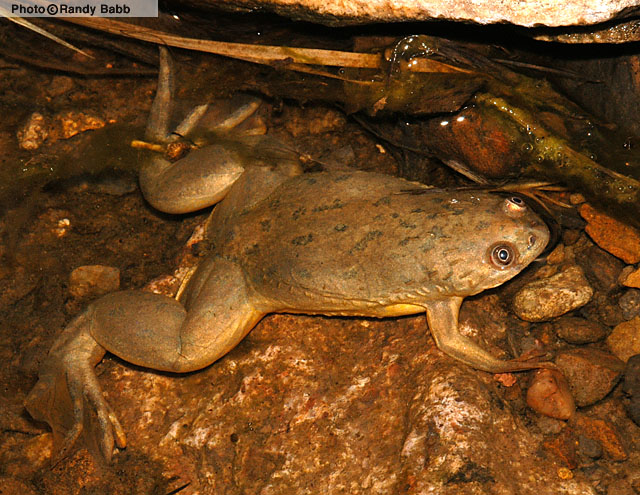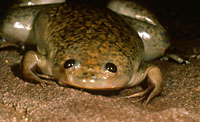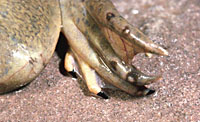Online Field Guide to The Reptiles and Amphibians of Arizona



Pima County, AZ
 Pima Co., AZ |
| AFRICAN CLAWED FROG Xenopus laevis | |
|
DESCRIPTION: African clawed frogs grow to about 5.5 inches in length and are characterized by a flattened head and body, small eyes that are turned upward, unwebbed slender fingers, but large, fully webbed hind feet, the inner three toes of which are equipped with large black claws. The back is light olive or brown with spots or faint reticulations. This species lacks a tongue, eyelids, and external eardrums. Males are about three-quarters the size of the females. Tadpoles grow to about 1.5 inches, are transparent with internal organs clearly visible, and have a tentacle on each side of the mouth. DISTRIBUTION: Native to the cooler regions of sub-Saharan Africa, the African clawed frog has been found in the wild in at least 11 of the United States, but has only established long-term, reproducing populations in southern California and Arizona. A large, breeding population has persisted at a pond at the Arthur Pack Golf Course in Tucson since the 1960s, and there have been reports from urban ponds in Phoenix, as well. Introductions have occurred via pets and laboratory animals (see “Remarks”) that have escaped or been released. HABITAT: In the United States, the African clawed frog is typically found in disturbed or human-altered aquatic habitats, such as reservoirs and artificial ponds. They are sometimes found in flowing water, but prefer the still water of ponds and impoundments with soft substrates, submerged vegetation, and water temperatures that remain above 680 F for most of the year. BEHAVIOR: The species is highly aquatic, but can colonize new areas via short overland movements that may occur in response to high population density or flooding. Young frogs may use areas of sheet flooding to move among ponds. Some researchers have suggested that African clawed frogs are unpalatable to predatory fishes; however, evidence from southern California suggest populations can be reduced or eliminated by black crappie and green sunfish predation. This frog is salt-tolerant and can aestivate for up to eight months when ponds dry out. REPRODUCTION AND CALLS: Reproduction has not been examined in Arizona; however, in California, African clawed frogs breed from January-November, with a peak of calling in April and May. The call is a two-part trill given underwater that lasts less than a second and may be repeated up to 100 times per minute. Females can lay up to thousands of eggs per clutch, and can produce several clutches per year. Eggs are laid singly or in small clumps. Tadpoles metamorphose in about 5-12 weeks. DIET: African clawed frogs feed primarily on slow-moving invertebrates, but will also take fishes, amphibians, birds, and carrion. They capture prey with a combination of a toothed jaw and their forelimbs, rather than using a tongue like other Arizona anurans. Cannibalism has been documented. The species is considered a threat to native fishes and frogs. In southern California, the African clawed frog is a predator of the threatened California red-legged frog (Rana aurora draytonii). REMARKS: This species was used as a laboratory animal in human pregnancy testing in the 1940s and ‘50s when it was discovered that they lay eggs after being injected with a pregnant woman’s urine. The species is now widely used in developmental, cellular, and molecular biological research. The African clawed frog is on the Arizona Game and Fish Department’s list of restricted live wildlife. It is illegal to possess an African clawed frog in Arizona without a permit. The African dwarf clawed frog (Hymenochirus boettgeri), common in the Arizona pet trade, is very similar to the African clawed frog, but only grows to about 1.5 inches in length. African clawed frogs may have been the source of the fungal skin disease, chytridiomycosis, which has been implicated in mass mortality and extinctions of frogs and toads around the globe. By Jim Rorabaugh
Crayon, J.J. 2005. Xenopus laevis (Daudin, 1802) African clawed frog. Pages 522-526 in M.J. Lannoo (ed), Amphibian Declines: The Conservation Status of United States Species. University of California Press, Berkeley, CA. McCoid, M.J. 1980. Observations of feral populations of Xenopus laevis (Pipidae) in southern California. Bulletin of the Southern California Academy of Science 79(2):82-86. Weldon, C., L.H. du Preez, A.D. Hyatt, R. Muller, and R. Speare. 2004. Origin of the amphibian chytrid fungus. Emerging Infectious Diseases 10(12):3-8. |
|
Visit Partners in Amphibian and Reptile Conservation:


HOME
Copyright © 2023, Arizona Game and Fish Department. All rights reserved.
If you make use of the textual contents of this site in reports, publications, etc. please cite and credit the author(s) and photographer(s). All photos on this website are copyrighted. However, those found in the species account section may be used for any noncommercial scientific, educational, or conservation purposes provided that photographs are not altered and continue to bear the copyright symbol and name of the photographer. Please contact the photographer regarding commercial use of copyrighted photographs.











